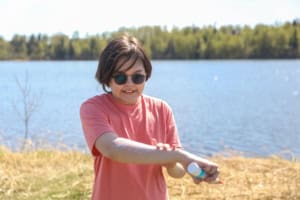Safety Tips to Protect Your Skin From UV Rays
By Public Relations Specialist Shamika Andrew

Protect yourself from harmful ultraviolet rays this summer!
Skin cancer is one of America’s most diagnosed cancers. The good news is it is also one of the most preventable forms of cancer. While skin cancer is cancer you can see, it often goes undetected in the early stages. A large percentage of this form of cancer is associated with exposure to ultraviolet radiation from the sun. To lower your risk, protect your skin from UV rays from the sun and from artificial sources such as tanning beds and sun lamps.
Spending time outside is a great way to promote physical activity, reduce stress, and get vitamin D. While enjoying the benefits of being outdoors, you can decrease your risk of developing skin cancer by using sun protection. Protection from UV rays is important all year, not just during the summer. UV rays can reach you on cloudy and cool days, and they reflect off surfaces like water, cement, sand, and snow. Protect your skin while enjoying the sun by following these simple safety tips:
Use sunscreen every day. Apply it at least 15 to 30 minutes before going outside and reapply every two hours. Make sure it is water resistant and has an SPF of 30 or higher.
Wear a long-sleeved shirt and long pants when you know you will be spending hours in the sun. Dark clothing made with tightly woven fabric blocks more sun than white or loosely woven fabric.
Wear sunglasses and a hat that shades your face, neck, and ears.
Be cautious if you are taking medications that may make your skin more sensitive to the sun.
Keep babies and small children in the shade and covered during extended periods of time in the sun.
“In addition to focusing on UV and sun protection, which can include protective clothing and using a good sunscreen, regularly examining any moles and blemishes on your skin and going in early to see your primary care provider if you notice any changes in color or size is one the best things you can do to prevent or treat skin cancer,” Anchorage Native Primary Care Center Medical Director Dr. Michael Cooper shared.
Get to know your skin. Check yourself in the mirror, and keep these three simple words in mind: new, changing, and unusual. A change in your skin is the most common sign of skin cancer. This could be a new growth, a sore that does not heal, or a change in a mole. Not all skin cancers look the same. Early detection of changes to moles or spots on the skin could save your life.
If you have questions about skin cancer, or would like to schedule an evaluation, reach out to your primary care provider to discuss your concerns. If you are diagnosed with a dermatologic condition, your provider will partner with you to create a treatment plan, which might include a referral to the Alaska Native Medical Center Dermatology Clinic.


